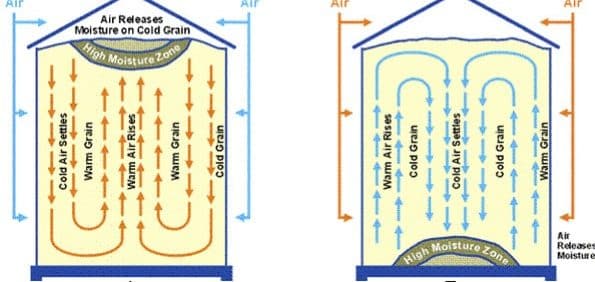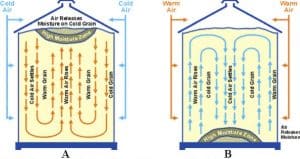Extended moments of warmer weather in winter can increase air and moisture movement inside bins. Put a priority on canola with moisture above 8% or higher dockage or green seed levels, all of which were more common after harvest 2018. While you’re at it, take a moment to check in on all bins. How to check bins.
Blowing cold air. Is running fans on cold days worthwhile to substantially drop the temperature of stored canola? Joy Agnew provided this response while she was grain storage researcher at PAMI:
Observations below are based on anecdotal and testimonial information and a bit of data. It’s hard to have a scientifically sound answer to every grain storage related question.
The main drawback with supercooling is the potential for the grain to “set up” – or get so cold it won’t flow. This can be a problem if the farmer needs to move it before it warms up. Plus, warming it up from this very cold state can take awhile since it’s difficult to get a decent, uniform airflow through a frozen grain mass and waiting for ambient warming will take several months. But the temperature at which this “set up” happens is pretty low, especially for dry or over-dry canola. My experience is that canola with moisture content of 9% or lower still flows even when the temp of the grain is -25°C. The other drawback is that, if the grain was still slightly tough, frozen tough grain is difficult to dry with natural-air drying (once you have conditions to do so again in the Spring). But freezing tough grain is a good way to minimize the risk of spoilage if there is no way to dry it in the fall. So there’s a tradeoff there. So, yes there are some downsides, but the benefit of more stable storage throughout the winter months probably outweighs them.
Further reading:
How outside temperature influences moisture migration in bins
“Storage risk” article in Canola Digest
Questions about handling high-moisture canola
Tough or damp canola: Storage risk


